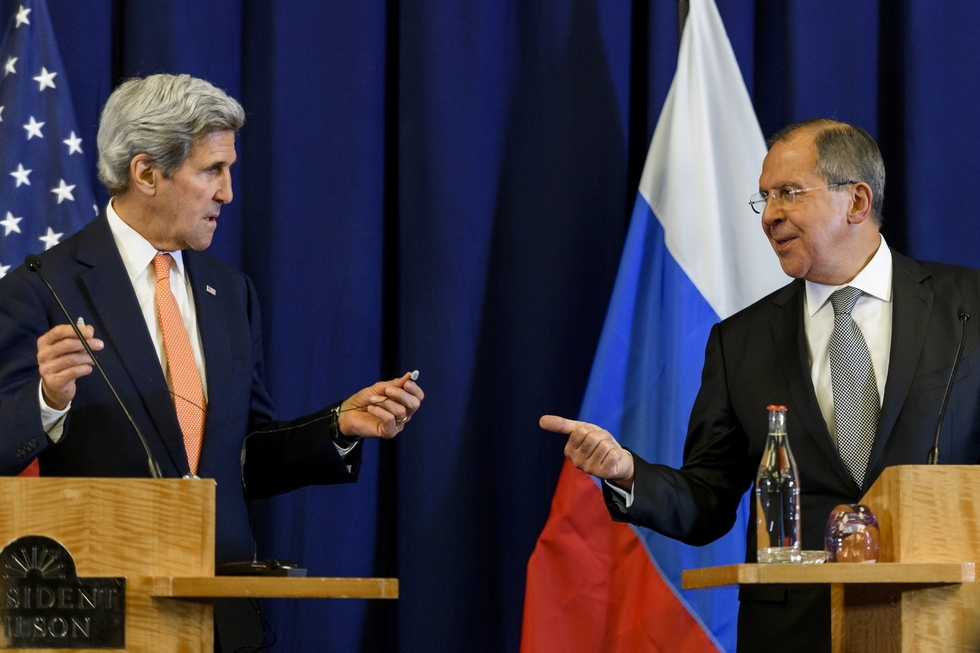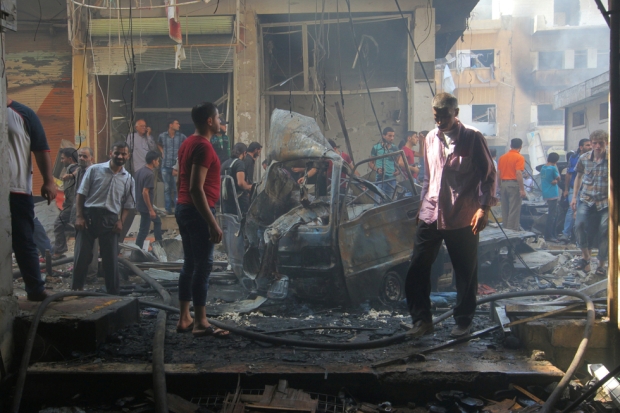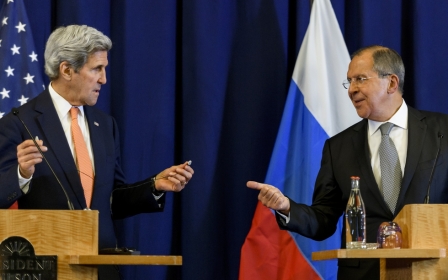ANALYSIS: Opportunities and pitfalls in Syrian ceasefire plan

The US and Russia on Friday agreed to push for a new ceasefire in Syria, with a plan for a cessation of hostilities between rebels and government forces on Monday, and possible joint US-Russia air strikes on groups both sides consider "terrorist".
It is the latest in a long line of attempts to end the fighting and unite focus on the Islamic State and the Nusra Front, which recently cut ties with al-Qaeda and renamed itself Jabhat Fateh al-Sham - a move neither the US nor Russia recognise.
The latest agreement resulted from hours of talks between John Kerry, the US secretary of state, and his Russian counterpart Sergei Lavrov. Middle East Eye examines the contents of the announcement, and the problems the plan faces.
The broad strokes
Russia and the US announced that a truce would come into effect on Monday, the first day of the Muslim holiday of Eid al-Adha, and it will be tested for a week before further cooperation measures are implemented.
Key to the deal is the withdrawal of Syrian government forces around rebel-held Aleppo, allowing humanitarian access to its starving residents.
New demilitarised zones would be created in the city, including the Castello Road, a main route into the rebel-held areas.
The Syrian regime will be ordered to suspend air strikes, the main cause of civilian deaths, on rebel-held areas around the country.
The US must persuade rebels groups to end hostilities and pull back from alliances with Nusra, while Russia must press the Syrian government and its allies to cease fire and pull back from the siege in Aleppo.
"That should put an end to the barrel bombs, an end to the indiscriminate bombing of civilian neighbourhoods," Kerry said.
If the truce holds for a week, Moscow and Washington will set up a joint coordination unit and begin air strikes against agreed "terrorist" targets - including in areas held by the Islamic State and Nusra.
From there, Kerry said the ceasefire would "resume movement towards a negotiated peace".
The main opposition group, the HNC, said on Saturday it welcomed the deal but added that it required Russia to use its influence over Syrian President Bashar al-Assad.
Lavrov said the Syrian government "has been informed by us about these arrangements, and it is ready to fulfil them," but added that Moscow could not "100 percent guarantee" that all the parties would obey the ceasefire.
Kerry was quick to state the deal was an "opportunity" and nothing more at this stage.
“No one is building this based on trust,” he said. “It is based on oversight, compliance, mutual interest. This is an opportunity, and not more than that until it becomes a reality.”
Joint air strikes
US and Russian cooperation against "terrorist" groups has been discussed for months. Russia in June suggested "compiling a joint map with actual information about location of forces active in Syria," but no deal has been implemented due to disagreements and continued fighting on the ground.
However, from Lavrov's comments on Friday, the coordination plan appears in its advanced stages.
"We will jointly agree on strikes against terrorists to be carried out by the Russian and American air forces. We have agreed on the zones in which these strikes will be carried out," said Lavrov.
Such cooperation, which could begin in 10 days should the ceasefire hold, will aid efforts to end the grip of IS on areas of Syria.
The group has suffered a string of defeats in northern Syria, first at the hands of the Kurd-led Syrian Democratic Forces in Manbij, and later by Turkish forces in the border town of Jarabulus.
Raqqa has been the ultimate goal of all sides opposed to IS - the SDF, Turkey and Saudi Arabia have all offered to aid its liberation in recent days.
The Syrian government has also fought against IS, removing it from Palmyra and setting its sights on the "race for Raqqa".
In theory, cooperation between Russia and the US would aid that battle, preventing Russian attacks on US-backed rebels advancing on the city and allowing for some unity of purpose in the field.
But the Pentagon on Friday warned that the plan would come into effect only if commitments by Moscow and the Assad regime were "fully met".
Stumbling blocks
IS holds territory and is a relatively easy target. The fight against Nusra, however, is far more complex, as the group is "embedded"' in rebel-held areas and has fought with a range of other rebel organisations on several fronts.
Defining the zones deemed to be controlled by Nusra will be one of the the most difficult parts of the deal to implement - disagreements on who is and who isn't an ally or member of Nusra could bring it crashing down.
A shaky truce in February fell almost immediately into chaos as Russia continued to bomb rebel forces on the pretext they were Nusra or IS - leading to more fighting on the ground, blocks on humanitarian aid efforts and the eventual collapse of the deal.
Since then, Russian air power has backed government troops to tighten their siege of Aleppo and force rebels out of Darayya, a suburb of the capital that had been in rebel hands since the initial uprising in 2011.
Syrian forces have continued to bomb civilian areas, with allegations it has been specifically targeting hospitals - the NGO Doctors Without Borders has reported numerous attacks on its facilities while the February agreement was in place.
And Russia and the US still do not agree on which groups should be deemed "terrorist" and therefore outside the bounds of any ceasefire.
In June, Russian planes allegedly bombed US-trained rebels from the New Syrian Army at al-Tanaf, near the Jordanian.
And violence continued unabated despite the announcement on Friday.
At least 30 were reported killed in an air attack on a market in rebel-held Idlib city on Saturday, while government forces launched fresh attacks on the rebel held area of Amriyah in Aleppo.
Charles Lister, a senior a senior fellow at the Middle East Institute think-tank, said the Friday deal would also depend on rebel groups changing an ingrained mindset.
"The armed opposition in Syria now faces what is perhaps its biggest and most momentous decision since they chose to take up arms against the Assad regime in 2011," he said.
He said mainstream rebels appear reluctant to withdraw from frontlines where Nusra are also present because of fears the ceasefire will fail.
"For this reason alone, many opposition figures see the US-Russia talks and whatever comes from them as a conspiracy against their long and hard fought for revolution. It will be hard to change this mindset."
Assad's future
The question of the future of President Assad also remains a major obstacle to peace.
The Syrian opposition group, the HNC, has been resolute about his removal, last week making his ousting the cornerstone of its latest "vision" for an end to the civil war - a call which is still supported by the US.
Russia has consistently rejected calls for Assad to step down, stating that his removal could destroy what is left of state institutions in Syria and lead to further chaos.
Echoing statements made during previous attempts to end the fighting, rebels groups said they saw little chance of the US-Russia plan succeeding because Damascus and Moscow would not abide by it.
Fares al-Bayoush, the head of the Free Syrian Army's "Northern Division," said Russia and Damascus had not observed the last agreement, and the chances of the new deal succeeding were the same as the last.
Captain Abdul Salam Abdul Razak, a military spokesman for the rebel Nour al-Din al Zinki brigades, said the deal would only give the Syrian army a chance to gather forces and pour more Iranian-backed militias into the main battles raging in Aleppo.
Much rests on what happens on Monday.
New MEE newsletter: Jerusalem Dispatch
Sign up to get the latest insights and analysis on Israel-Palestine, alongside Turkey Unpacked and other MEE newsletters
Middle East Eye delivers independent and unrivalled coverage and analysis of the Middle East, North Africa and beyond. To learn more about republishing this content and the associated fees, please fill out this form. More about MEE can be found here.






